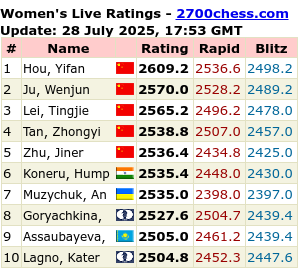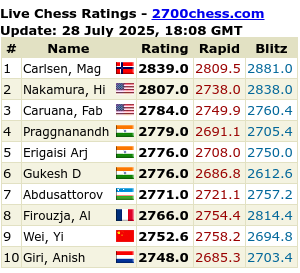5 May 2010 – GM Topalov is playing white with 1.d4 opening. The Slav Defense transpired during the game.
Pix 1. White played 10. Qxd4. The exchange of queens next, 10…Qxd4.

Pix 2. Topalov and Anand during game 8 (courtesy of chessdom.com)
Here is a running commentary from susanpolgar’s website of game 8 of the World Chess Championship up to move 38.
Veselin Topalov - Vishy Anand
World Championship (game 8)
1. d4 d5 2. c4 c6 3. Nf3 Nf6 4. Nc3 dxc4 5. a4 Bf5 6. Ne5 e6 7. f3 c5 8. e4 Bg6 9. Be3 cxd4 10. Qxd4 Qxd4 11. Bxd4 Nfd7 12. Nxd7 Nxd7 13. Bxc4 Both sides chose to repeat the Slav.
13...Rc8 New move by Anand. Once again, Anand is the first to deviate. Both Anand and Topalov are cranking out these moves at lightning speed.
14. Bb5 Even though Topalov faced a different move than the earlier game, he responded with this immediately.
14...a6 15. Bxd7 Kxd7 16. Ke2 So where do we stand? White has a small advantage because:
a) Piece development. All of Topalov's pieces are developed and ready for action.
b) Space advantage.
What does Anand need to do?
a) f6 to get his g6 Bishop back to the other side.
b) Get his other pieces out ASAP.
16...f6 17. Rhd1 I guess Topalov doesn't seem to mind having this type of position again. Anand has 2 interesting choices: 17...Ke8 or bring his King to the other side 17...Kc7. Both are playable.
17...Ke8 Anand chose this choice. If Anand is successful in getting his Bishops and Rook on h8 out, this game will end in another draw. If Topalov wants to win, he must find a way to keep Anand's pieces out of play. The plan is clear for both.
18. a5 The general idea for Black to get his pieces out: Bb4, Ke7, Rhd8, then Bf7 and e5. But of course Topalov will not sit still and allow Black the freedom to develop. This endgame is interesting is because Topalov has won many games with less advantage than this and Anand has successfully held games with positions worse than this. As we have seen in the previous Slav games, Anand was very patient in getting his pieces out, one at the time, and held nicely.
Black is down by 20 minutes on the clock already. Our friends at Chessdom has many pictures available here: http://photo.chessdom.com/index.php?cat=10025
Do you have other plans for Anand? How can he get all his pieces out?
18...Be7 19. Bb6 Topalov responded with this immediately. Anand is now behind by more than 25 minutes on the clock. The problem for Anand is if Kf7 then Rd7 with a strong advantage. Remember, Black can no longer castle.
19...Rf8 20. Rac1 f5 Since Anand is having a hard time getting his Rook to the d file, he is trying to open up the f file. I would play e5 here and not help Black to open the position. If 21. e5 Bg5 22. Be3 +=
21. e5 
Pix 3. White played 21.e5.
21...Bg5 Topalov should play Be3 to trade the Bishops. White's Knight is much better than Black's g6 Bishop in the endgame, especially when White's key pawns are on the dark squares.
22. Be3 f4 Anand obviously could not allow this trade which leads to a horrible endgame. But now Topalov has this option: 23. Nb5 Rxc1 24. Nd6+ Kd7 25. Bxc1+=. White can also play 23. Ne4 instead of Nb5 with the same continuation.
23. Ne4 OK! Topalov found the suggested line above.
23....Rxc1 24. Nd6+ (diagram below) White has a good advantage here.
Pix 4. White played 24.Nd6+… opening up the game for white with this move.
Black still has plenty of problems getting his Rook and Bishops in play. Anand has 2 options: 24...Kd7 or 24...Ke7. The first one is stronger because Black needs to get his King to the other side to clear room in the center for his pieces. Anand has a lot of work to do to hold this game.
Another thing to keep in mind about the importance of this game: After game 4, Topalov was in a world of trouble mentally and emotionally. To start out with 2 losses with Black after a high of winning the opening game was big. After holding the first Black game (game 6) with ease, he went all out for the win with Black in game 7. Therefore, even though Topalov is down by 1, he seems to slowly regain momentum and most importantly, his self confidence. This is why this game is huge. If Topalov scores here, the entire momentum of the match will shift dramatically. Anand also knows that Topalov is notorious for finishing strong.
On the other hand, if Anand can hold this game, Topalov will be very frustrated and short of patience since there will only be 4 games left. This may cause him to do something more risky which may cost him another game and match.
Just like in any other sport, momentum is so important. Just look at Fischer in 1972. After a slow start, Fischer never looked back after a big win. He eventually won the match by a sizable margin. The same happened to me in my match against Xie Jun in 1996. After a big win, I continued to score win after win and my 4th world titles.
Chess is a lot more than just Fritz and Rybka home analysis. Mental and emotional status is so important.
24...Kd7 Anand wisely chose the right path to bring his King to the other side.
25. Bxc1 Kc6 26. Bd7 Be7 Anand wants to trade this Bishop for the Knight, even at the expense of potentially losing the f4 pawn, to have a Bishop opposite color endgame. Here is an important lesson to remember: If we go back a few moves earlier after White played 22. Be3, the dynamics of the game change so much based on which piece is off the board. If those 2 Bishops are traded, White would have a big edge with a Knight vs. the g6 Bishop endgame. On the other hand, if the same Bishop is traded for White's Knight, Black would have an easier time holding. Keep this in mind in your own games. One should never trade pieces randomly. There should always be proper evaluation when trades occur.
There are many sites which offer LIVE commentary and analysis. Many of them are very sophisticated with deep computer lines. My style is different. I prefer to explain chess in layman terms so everyone can understand and benefit from. If people want Rybka analysis, they can do it themselves at home without me :)
I also employ the same philosophy when I teach, especially at my online classes. In my opinion, it is much more important to understand chess than memorizing Fritz and Rybka lines.
27. Rc1+ Kd7 White still has a decent advantage. Anand's plan is simple: Trade Rooks and e7 Bishop for the Knight. Here is one possible line: 28. Bb4 Bxd6 29. Rd1 Kc8 30. Rxd6 +/-
I was asked if Bishop opposite color endgames always lead to draws. The answer is no. In this game, Rooks are still on the board so White still has chances to convert. I have won a number of games in my career with Bishops opposite color endgames. It just means that it is easier to hold but not automatic draw.
28. Bc3 An unexpected choice. White is still doing fine.
28...Bxe6 29. Rd1 Black can defend his pawn with Bf5. This is why I prefer 28. Bb4 better because of a possible discovery.
29...Bf5 30. h4 White is in no rush to recapture the Bishop on d6. It is going nowhere. The idea of h4 is to block g5 defending the f4 pawn. Topalov wants to take the Bishop with the pawn then Be5 attacking the f4 pawn. The Black Rook cannot defend that pawn and the c file at the same time after White plays Rc1 with the threat of Rc7.
Both sides have no problem with time. Anand has about 45 minutes for 10 moves while Topalov has more than 60.
By the way, after 29. Rd1, 29...Kc8 is also playable. The position is not lost for Black, just difficult to defend and it requires a lot of patience and accuracy. Anand has plenty of time on the clock to figure things out.
By the way, in addition to understanding chess, one must also be efficient in chess tactic and endgame. This is why I usually post multiple puzzles every single day on my blog, with various levels of difficulty. I usually try to post important must know endgame themes as well as many different tactical patterns. When you continue solving these puzzles daily, it will help you understand and recognize a variety of chess patterns much better. This is why I also delay publishing the comments. I want to give you time to exercise your chess minds and skills and not have the temptation of peeking at the solutions posted by others. I know. I am mean but it is for your own good :) Yes, and you can blame me for overloading your brains with chess stuff on this blog :)
30...g6 31. Rxd6+ Kc8 Now Bd2 and the f4 pawn will eventually fall.
32. Bd2 Now it is Anand's task to hold a pawn down Bishop opposite color Bishops.
32...Rd8 Now White should not take on d8. He wants to wait for Black to take then take back with the pawn so he can have a passed pawn. Otherwise, he will virtually have no chance to win.
33. Bxf4 Rxe6 34. exd6 Kd7 I have news for you. This game may go 100 moves. I can assure you that Topalov will try to grind this out all the way. This is his chance to even up the match. It is not an easy position to hold for Black in spite of the opposite color Bishops.
35. Ke3 with the threat of Kd4, e5, f6.
35...Bc2 Topalov should continue with the Kd4 plan. If Topalov wants to win this World Championship, he must do everything possible to win this game. It is not easy to get a better position than this.
36. Kd4 Ke8 A wise move to bring his King to f7. If the White King gets to f6, it is all over for Black. Anand's defensive plan is to have his Bishop of d5 / c6 and King on f7 / e8.
37. Ke5 Kf7 If Bg5 then Ba4. It is possible for Black to hold with perfect play.
38. Be3 If 38. Bg5 Ba4 39. b3 then Bd7
38...Ba4 
Pix 5. Black played 38…Ba4.
39. Kf4 Bb5 40. Bc5 Topalov made time control with more than 30 minutes to spare.
I cannot find any "winning" line for White. All he can do is keep on trying to improve his position while Black has to be absolutely accurate with his defense.
40...Kf6 41. Bd4+ A necessary move to try to push the King back and not to give Black space. I am looking 41...e5+ sacrificing a second pawn to free the e6 square for the King. This may make holding a little easier since I see little chance for White to make progress. In a blitz or casual game, I would sacrifice this pawn in a second. But in a World Championship, double, triple, and quadruple checking this sac is required :)
41...Kf7 A safe move. Can you blame him? :) But now Anand has to focus on the idea of Kg5, Kh6, then march his pawns up.
42. Kg5 By the way, another piece of information for everyone who uses computers to follow this game. While Rybka and other top programs are deadly when it comes to many positions in chess, they still have a hard time evaluating closed and positional positions as well as endgames with more than 6 pieces on the board. I have no idea what the current evaluation by Rybka is but I assume it is between +1 and +1.5. The reason for that is most computer software count materials as a part of the overall evaluation. This is why understanding chess instead of just following chess software recommendations blindly is so important.
42...Bc6 43. Kh6 Kg8 44. h5 If 44...gxh5 then 45. Kf6 and it is over.
44...Be8 45. Kg5 Kf7 Anand is defending perfectly up to now. If he keeps this up, he will hold this game. I believe that Topalov understands that there is no forced win. What he is figuring out is how to create as much complication as possible hoping for an Anand's inaccuracy.
46. Kh6 Kg8 47. Bc5 Topalov is trying to create zugzwang situation for Black. It is almost but not quite as Black still has gxh5 and Kh8.
47...gxh5 48. Kg5 and now Black must play Kg7 to protect the f6 square.
48...Kg7 49. Bd4+ Kf7 Some progress but still no concrete winning plans for White.
50. Be5 h4 This pawn cannot be protected anyway. Therefore, with this move, Black is getting the White King to move back a little for some breathing room.
51. Kxh4 This is still not a "dead draw" yet. Black still has to defend accurately for many more moves. Now Black needs to get his King more active with Kg6. It is dangerous to allow a lurking Topalov's King :)
51...Kg6 52. Kg4 Get your snack, popcorn, lunch, dinner (whichever time zone you are in) and drinks out. This will be the longest game of the match so far.
By the way, a number of people have counted Topalov out already. Don't :) There are still 4 games left after this game and the pressure will rise as each game passes. Anything can happen in 4 games as we clearly saw in the first 4 games. It is never over until it is over and crazy things do happen when players are under intense pressure.
52...Bb5 53. Kf4 Topalov can try to bring his King back and forth between the King and Queenside. Black cannot use his Bishop to attack White's pawns because of the d6 pawn. Both sides have plenty of time so no time pressure excuse :) 
Pix 6. White played Kf4.
53...Kf7 I do not see the immediate need to retreat the King. The King should only retreat when forced.
54. Kg5 Anand spent a lot of time for his last move while Topalov played immediately. This is a part of the mind game. Topalov does not have to make "perfect" moves every time since this is not a dynamic position. Anand does in this position. By Topalov playing "very fast", his opponent may start to wonder if he made a blunder and the other side found a win.
54...Bc6 55. Kh6 Kg8 56. g4 Black cannot take on f3 because of d7. Black has a serious problem with the plan of g5, Bg7, then g6. Black must then take on g6. Now White can take back with King and then Kf6. It is hard to defend against this.
Anand just resigned!! Shocking! I know that the position is bad but what is the rush to resign immediately? Why not play a little longer to see if Topalov can find the right plan. There is no harm in that.
1-0
As I said earlier, it is not an easy draw but with proper defense, I still believe Anand can hold. But that means that just about every single move has to be accurate. As I also said earlier, do not trust your computer evaluation when it comes to endgame unless it is 6 pieces or less. I have to go back to see where Anand made the mistake.
A brilliant display of endgame techniques by Topalov. Now we have a completely different match. Anand no longer has any breathing room. He cannot coast toward the finish line hoping for a rapid playoff.
The only thing that I can compare this to is like a heavyweight boxing match. The strategy is to keep going for the body shots round after round. Then at the later rounds, you go for the knockout punch.
Many people criticized Topalov for choosing the same opening over and over again. If you remember Topalov's performance in San Luis, he did not win by going all out in every game. He won games with different styles: all out attack, slow squeezing games, and endgame conversion.
Update: I just looked at the end again to see where Anand went wrong. I believe that 54...Bc6 was not accurate. I like 54...Bd3 better. White cannot play d7 because of Ke7. I think it is important to keep both the Bishop and King more active. Please feel free to add more analysis or correct this idea of mine.
For those who are curious as to why Anand resigned, here is why: 56. g4 Be8 57. g5 Bc6 58. Bg7 Be8 59. f4 Bd7 60. g6 hxg6 61. Kxg6 +-
Pix 6. White played 56.g4 and black resigned. Topalov wins 1-0 and evens overall score to 4-4.

































No comments:
Post a Comment